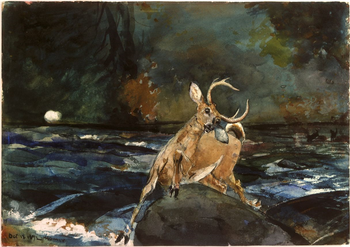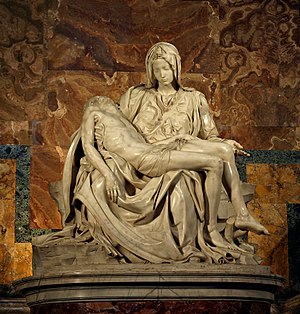Scale and proportion
From WikiEducator
| Art Appreciation and Techniques (#ART100) | |
|---|---|
| The visual language: Artistic principles | Overview | Introduction | Visual balance | Repetition | Scale and proportion | Emphasis | Time and motion | Unity and variety | Summary |
Scale and proportion show the relative size of one form in relation to another. Scalar relationships are often used to create illusions of depth on a two-dimensional surface, the larger form being in front of the smaller one. The scale of an object can provide a focal point or emphasis in an image. In Winslow Homer’s watercolor A Good Shot, Adirondacks, the deer is centered in the foreground and highlighted to assure its place of importance in the composition. In comparison, there is a small puff of white smoke from a rifle in the left center background, the only indicator of the hunter’s position. Scale and proportion are incremental in nature.
When scale and proportion are greatly increased the results can be impressive, giving a work commanding space or fantastic implications. Rene Magritte’s painting Personal Values constructs a room with objects whose proportions are so out of whack that it becomes an ironic play on how we view everyday items in our lives. American sculptor Claes Oldenburg and his wife Coosje van Bruggen create works of common objects at enormous scales. Their Stake Hitch reaches a total height of over 53 feet and links two floors of the Dallas Museum of Art. As big as it is, the work retains a comic and playful character, given in part to its gigantic size.

